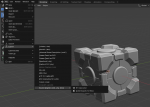Blender Source Tools Help: Difference between revisions
Jump to navigation
Jump to search
TomEdwards (talk | contribs) (doesn't seem like a good choice of package to me, but hey...) |
m (Robot: fixing template case.) |
||
| Line 3: | Line 3: | ||
'''To learn about the general usage of Blender, see [[Is Blender 3D Good for Source/How to Start]].''' | '''To learn about the general usage of Blender, see [[Is Blender 3D Good for Source/How to Start]].''' | ||
{{ | {{TODO|Is it not possible to export collision meshes? That's crap!}} | ||
== The export process == | == The export process == | ||
Revision as of 19:17, 19 January 2009
This tutorial will show you how to export a simple model from Blender for compiling with studiomdl.
To learn about the general usage of Blender, see Is Blender 3D Good for Source/How to Start.
Todo: Is it not possible to export collision meshes? That's crap!
The export process
- Create your model and texture it via UV mapping. The result should be a .blend file and all the TGA files you used as textures. The example used here is the PC Gamer UK mag secreted all around de_dust_pcg (blender file for the model
pcgmag.blendand texture filepcgmag.tga) - Having installed the SMD exporter plugin, export your model to a Half-Life 2 SMD file, in this case
pcgmag.smd. - Copy the SMD file into
<game>/modelsrcand the TGA file(s) into<game>/materialsrc/models - The SMD you have already is just the reference model. We will also need an additional SMD to declare the 'idle' animation. So, in a text-editor, create a file called
pcgmag_idle.smd(or some other name ending in SMD) and enter this as its contents:
version 1 nodes 0 "joint0" -1 end skeleton time 0 0 0.000000 0.000000 0.000000 0 0.000000 0.000000 end
You are now ready to compile the model.
